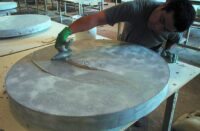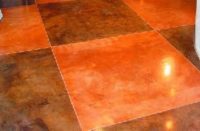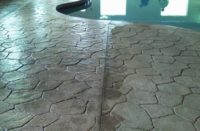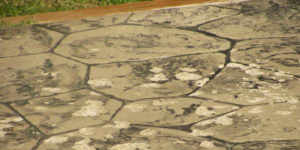There are three things in this world that have room for improvement: cell phones, microwave popcorn and, you guessed it, concrete sealers. There have been more prayers and cuss words offered up regarding sealers than over any other decorative concrete issue. I have always felt this way, and my suspicions have been confirmed during the Q & A part of the “Troubleshooting Decorative Concrete” seminar at every World of Concrete. I’m betting 90 percent of the questions are related to allegedly foolproof sealers that went south.
Well, before you do something drastic, put that sharp trowel down and take note of some successful remedies.
Let me lay some groundwork by saying most, but not all, sealer problems are moisture-related. Moisture issues can include sealing too early, humidity, lawn sprinklers or drainage issues. The bottom line is that you as the decorative installer inherit all of the above issues because they make your work look bad. Believe me when I say that I have pointed fingers in every direction possible, and inevitably I was still the one that had to repair the problem. This is not to say proper front-end work (prior to beginning installation) will not hold off many of these issues. This type of front-end work is invaluable. But many times, you will find yourself helpless regarding what happens on the job after you’re done. Trust me.
Many sealer problems are not recognized until your client calls for a reseal or rewax. Some customers call for a reseal thinking this will fix the problem areas. It won’t — in fact, it will only make things worse. We must solve the existing problem before we can spray a new coat of sealer. I have been tempted many times to simply clean and reseal, justifying it by saying that the damaged areas were not my fault, but I haven’t. Fixing the issue is the only option, and the good news is that it may be much easier than you think. Remember, guys, that this is a win-win situation, because there is great money in decorative concrete maintenance. Let’s look at some sealer removal methods that will help you get your sealer issues back on track.
Solvent solutions – Using solvents such as xylene will break down most sealers, but I must warn you this is a smelly and messy way of doing it. For years my company used this method, and each job seemed to be worse than the last. My crew, definitely not whiners, got to where they would look like I had asked them to change a baby’s diaper when it was time to strip a sealer this way. I can’t blame them. If you must use this method, be sure to have your work area well vented and your lungs and eyes protected. Try using cotton sheets to hold the solvent to the concrete surface, and keep them moist. This method is slow but it will work. It will also work best in the cool temperatures of morning.
Soy-based strippers – I have tried some of the soy-based strippers, and I must be honest and say the verdict is still out. I feel they will work, but contractors should realize that this may take some time, especially when stripping multiple coats of sealer. The good news is that the smell is a nonissue, and disposal is a nonissue because of the biodegradable nature of soybeans.
The stripper itself can be expensive unless you have a local distributor in your area. It will be well worth your time to call the manufacturer ahead of time to make sure you have the right product and instructions. Again, as with most removal methods, the number of seal coats will determine the time needed to strip. The good news is that in most cases not all the sealer needs to go away, just the damaged or failing part. This stripper type definitely has its place in the market.
Hot water – Now this is where the rubber hits the road. This removal method is my favorite. I have found it to be the most effective and cost-saving way to remove sealer yet. My company will usually outsource sealer removal to a company that specializes in stripping coatings with the use of hot-water pressure washing. The results have been nothing short of amazing and allow my crew to stay focused on moneymaking projects. Many hot-water systems allow for flexible water temperatures until the necessary extraction temperature is reached. This combination of hot water and pressure is hard to beat. Because of this high pressure, little water is used, especially when you factor in that the sealer is removed and the concrete is made clean and ready for a fresh coat of sealer all in one step. Some stubborn sealers may need a light chemical treatment prior to being pressure-washed but most won’t. In my opinion, this is the most overlooked method of repairing sealers I know. Obviously, using it on many indoor projects would be a challenge, but I recommend doing some research on this method of removal.
Dollar consciousness
Most contractors across the country — and the world — are in a preservation state of mind in this current economy, my business included. Some interesting numbers have been released lately, and one thing especially caught my eye and I wanted to share it with you for what it is worth. Two of the few “blue-chip” corporations claiming profits in 2008 were McDonald’s and Wal-Mart. I’m sure you know that both of these companies are built on low prices and will service middle- to high-end users but do not market to them. Guys, watch for the trend that this sets, because your services, at least in this economy, must be perceived as affordable and durable. Evaluate your services and promote simple yet basic options for customers that are extremely dollar-conscious. Your high-end customers will buy regardless, but the high end is shrinking with thousands of broke millionaires. The goal should be to provide outstanding service at an affordable price in order to keep fresh cash moving through your business. This is what it will take to come out the other side.















